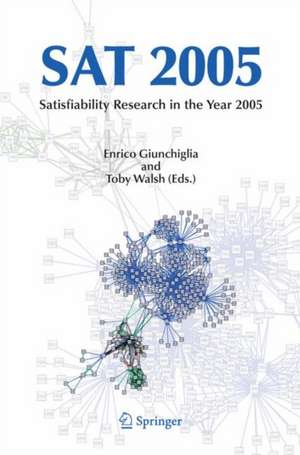SAT 2005: Satisfiability Research in the Year 2005
Editat de Enrico Giunchiglia, Toby Walshen Limba Engleză Hardback – 30 oct 2006
In 1960, Martin Davis and Hillary Putnam introduced their eponymous decision procedure for satisfiability reasoning (though, for space reasons, it was quickly superseded by the modified procedure proposed by Martin Davis, George Logemann and Donald Loveland two years later). In 1971, Stephen Cook's proof that propositional satisfiability is NP-Complete placed satisfiability as the cornerstone of complexity theory.
| Toate formatele și edițiile | Preț | Express |
|---|---|---|
| Paperback (1) | 987.17 lei 6-8 săpt. | |
| SPRINGER NETHERLANDS – 3 dec 2014 | 987.17 lei 6-8 săpt. | |
| Hardback (1) | 994.08 lei 6-8 săpt. | |
| SPRINGER NETHERLANDS – 30 oct 2006 | 994.08 lei 6-8 săpt. |
Preț: 994.08 lei
Preț vechi: 1242.59 lei
-20% Nou
Puncte Express: 1491
Preț estimativ în valută:
190.28€ • 206.75$ • 159.94£
190.28€ • 206.75$ • 159.94£
Carte tipărită la comandă
Livrare economică 21 aprilie-05 mai
Preluare comenzi: 021 569.72.76
Specificații
ISBN-13: 9781402045523
ISBN-10: 1402045522
Pagini: 300
Ilustrații: VII, 293 p.
Dimensiuni: 155 x 235 x 25 mm
Greutate: 0.61 kg
Ediția:2006
Editura: SPRINGER NETHERLANDS
Colecția Springer
Locul publicării:Dordrecht, Netherlands
ISBN-10: 1402045522
Pagini: 300
Ilustrații: VII, 293 p.
Dimensiuni: 155 x 235 x 25 mm
Greutate: 0.61 kg
Ediția:2006
Editura: SPRINGER NETHERLANDS
Colecția Springer
Locul publicării:Dordrecht, Netherlands
Public țintă
ResearchCuprins
Satisfiability in the Year 2005.- Heuristic-Based Backtracking Relaxation for Propositional Satisfiability.- Symbolic Techniques in Satisfiability Solving.- Exponential Lower Bounds for the Running Time of DPLL Algorithms on Satisfiable Formulas.- Backdoor Sets for DLL Subsolvers.- The Complexity of Pure Literal Elimination.- Clause Weighting Local Search for SAT.- Solving Non-Boolean Satisfiability Problems with Stochastic Local Search: A Comparison of Encodings.- Regular Random k-SAT: Properties of Balanced Formulas.- Applying SAT Solving in Classification of Finite Algebras.- The SAT-based Approach to Separation Logic.- MathSAT: Tight Integration of SAT and Mathematical Decision Procedures.
Textul de pe ultima copertă
This book is devoted to recent progress made in solving propositional satisfiability and related problems. Propositional satisfiability is a powerful and general formalism used to solve a wide range of important problems including hardware and software verification. The core of many reasoning problems in automated deduction are propositional. Research into methods to automate such reasoning has therefore a long history in artificial intelligence. In 1957, Allen Newell and Herb Simon introduced the Logic Theory Machine to prove propositional theorems from Whitehead and Russel's "Principia mathematica".
In 1960, Martin Davis and Hillary Putnam introduced their eponymous decision procedure for satisfiability reasoning (though, for space reasons, it was quickly superseded by the modified procedure proposed by Martin Davis, George Logemann and Donald Loveland two years later). In 1971, Stephen Cook's proof that propositional satisfiability is NP-Complete placed satisfiability as the cornerstone of complexity theory.
As this volume demonstrates, research has continued very actively in this area since then. This book follows on from the highly successful volume entitled SAT 2000 published five years ago. The papers in SAT 2005 fall (not entirely neatly) into the following
categories: complete methods, local and stochastic search methods, random problems, applications, and extensions beyond the propositional.
In 1960, Martin Davis and Hillary Putnam introduced their eponymous decision procedure for satisfiability reasoning (though, for space reasons, it was quickly superseded by the modified procedure proposed by Martin Davis, George Logemann and Donald Loveland two years later). In 1971, Stephen Cook's proof that propositional satisfiability is NP-Complete placed satisfiability as the cornerstone of complexity theory.
As this volume demonstrates, research has continued very actively in this area since then. This book follows on from the highly successful volume entitled SAT 2000 published five years ago. The papers in SAT 2005 fall (not entirely neatly) into the following
categories: complete methods, local and stochastic search methods, random problems, applications, and extensions beyond the propositional.
Caracteristici
Presents an up to date snapshot of a very active research area Provides many practical applications (especially in the area of hardware verification) Presents a survey of the breadth of research in this area
